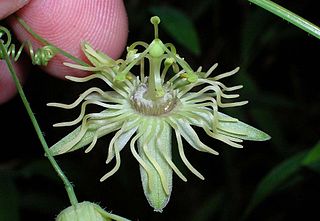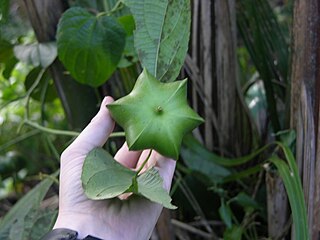
Marah are flowering plants in the gourd family (Cucurbitaceae), native to western North America. The genus was named for Marah in Exodus 15:22–25, which was said to be named for the bitter water there.

Symphoricarpos, commonly known as the snowberry, waxberry, or ghostberry, is a small genus of about 15 species of deciduous shrubs in the honeysuckle family, Caprifoliaceae. With the exception of the Chinese coralberry, S. sinensis, which is indigenous to western China, all species are native to North and Central America. The name of the genus is derived from the Ancient Greek words συμφορεῖν (sumphoreîn), meaning "to bear together", and καρπός (karpós), meaning "fruit". It refers to the closely packed clusters of berries the species produces.

Marah oreganus, the Oregon manroot, coastal manroot or western wild-cucumber, is a common manroot of the northwest coast of the United States. It ranges from California north to Canada.

Passiflora lutea, commonly known as yellow passionflower, is a flowering perennial vine in the family Passifloraceae, native to the central and eastern United States. The vine has three-lobed leaves and small, yellowish-green, fringed flowers that appear in the summer, followed by green fruit that turn almost black at maturity. It grows in moist to wet habitats.

Marah watsonii, the taw manroot, is an uncommon species in the genus Marah endemic to central northern California. Its range is bounded by the eastern coastal foothills, the western foothills of the northern Sierra Nevada and Cascades ranges and from Lake Berryessa in the south to Lake Shasta in the north.

Ceanothus integerrimus, known by the common name deer brush, is a species of woody shrub in the family Rhamnaceae, native to the western United States in Arizona, New Mexico, California, Oregon, and Washington. It grows in montane chaparral and woodlands regions, in hardwood forests, and in fir, spruce, and Ponderosa pine plant communities, being most abundant in the California chaparral and woodlands and Sierra Nevada.

Momordica balsamina is a tendril-bearing annual vine native to the tropical regions of Africa, introduced and invasive in Asia, Australia, Central America, and North America, where they have been found in some parts of Florida. In 1810, Thomas Jefferson planted this vine in his flower borders at Monticello along with larkspur, poppies, and nutmeg.

Marah macrocarpa, known as chilicothe, wild cucumber, manroot or bigroot is a species of plant in the genus Marah.

Crupina vulgaris is a species of flowering plant in the family Asteraceae. Its common names include common crupina, bearded-creeper, false saw-wort, and starry scabious. It is native to parts of Europe, Asia, and North Africa, and it is known elsewhere as an introduced species and often a noxious weed.

Plukenetia volubilis, commonly known as sacha inchi, sacha peanut, mountain peanut, Inca nut or Inca-peanut, is a perennial plant in the family Euphorbiaceae, having small trichomes on its leaves. It is native to much of tropical South America, as well as some of the Windward Islands in the Caribbean. It is cultivated commercially in South East Asia, most notably in Thailand. Although its raw seeds and leaves contain toxins, these components are safe for consumption after roasting.

Geranium carolinianum is a species of geranium known by the common name Carolina crane's-bill, or Carolina geranium. This species is native to North America, where it is widespread and grows in many types of habitat. There are two varieties; Geranium carolinianum var. carolinianum and the Geranium carolinianum var. sphaerospermum. This is a summer or winter annual herb. It can be considered invasive depending on the region, when it is found in the United States it is considered to be native.

Agoseris apargioides is a species in the family Asteraceae, is commonly called seaside agoseris or seaside false-dandelion. It is native to the Pacific coast of the United States from Washington to central California, where it grows primarily on coastal dunes.

Ludwigia peploides is a species of flowering plant in the evening primrose family known by the common names floating primrose-willow and creeping water primrose. It is native to Australia, New Zealand, North America, and South America, but it can be found on many continents and spreads easily to become naturalized. It is well known as a troublesome aquatic noxious weed that invades water ecosystems and can clog waterways. This is perennial herb which grows in moist to wet to flooded areas. The stem can creep over 2 meters long, sometimes branching. It spreads to form mats on the mud, or floats ascending in the water. The leaves are several centimeters long and are borne in alternately arranged clusters along the stem. The flower has 5 to 6 lance-shaped sepals beneath a corolla of 5 or 6 bright yellow petals up to 2.4 centimeters long. The fruit is a hard, cylindrical capsule.

Marah horridus, common name Sierra manroot, is a species of flowering plant in the family Cucurbitaceae, endemic to the foothills of the Sierra Nevada and the Tehachapi Mountains in California. It grows in open and shrubby areas below 1,000 m (3,300 ft) elevation.

Pinguicula orchidioides is a perennial rosette-forming insectivorous herb native to Mexico and Guatemala. A species of butterwort, it forms summer rosettes of flat, succulent leaves up to 5 centimeters (2 in) long, which are covered in mucilaginous (sticky) glands that attract, trap, and digest arthropod prey. Nutrients derived from the prey are used to supplement the nutrient-poor substrate that the plant grows in. Uniquely among Pinguicula species from the Americas, p. orchidioides produces gemma-like basal buds which elongate into stolons and serve as a means of asexual reproduction. In the winter the plant forms a non-carnivorous rosette of small, fleshy leaves that conserves energy while food and moisture supplies are low. Single purple flowers appear between July and September on upright stalks up to 22 centimeters long.

Cyclamen hederifolium, the ivy-leaved cyclamen or sowbread, is a species of flowering plant in the family Primulaceae. This widespread cyclamen species is widely cultivated and among the most hardy and vigorous in oceanic climates. It is native to woodland, shrubland, and rocky areas in the Mediterranean region from southern France to western Turkey and on Mediterranean islands, and naturalized farther north in Europe and in the Pacific Northwest.

Passiflora suberosa is a species of passionflower that is native to the Americas. It is commonly known as corkystem passionflower due to the corkiness of older stems. Other common names include corky passion vine, cork-bark passion flower, corkstem passionflower and corky passionfruit. In Latin America it is called Meloncillo. It is possibly also cryptic and have multiple species in one.

Thomcord is a seedless table grape variety and a hybrid of the popular Thompson Seedless or Sultanina grape and Concord grape. Thomcord was developed in 1983 by Californian grape breeders working for the Agricultural Research Service (ARS), an agency of the United States Department of Agriculture (USDA), as part of a test to better understand a new seedless grape breeding procedure.

Dolichandra unguis-cati, commonly known as cat's claw creeper, funnel creeper, or cat's claw trumpet, is a rapidly growing climbing vine belonging to the family Bignoniaceae. It affects all plant layers of the forest ecosystem spreading rapidly both vertically and horizontally.
Marah gilensis, commonly known as the Gila manroot, is a species of flowering plant in the family Cucurbitaceae, endemic to Arizona and New Mexico in the United States.



















